

Disabled readers suffer from visual and auditory impairments but not from a specific magnocellular deficit. "The Genetics and Neurology of Dyslexia" A Galaburda 2013. Genetics of dyslexia: the evolving landscape. + Author Affiliations Correspondence to: Professor M M Nöthen Department of Genomics, Life & Brain Centre, University of Bonn, Sigmund-Freud-Strasse 25, D-53105 Bonn, Germany; markus.noethen@uni-bonn.de Received 20 September 2006 Accepted 22 January 2007 Revised 13 January 2007 Published Online First 16 February 2007 Abstract Dyslexia is among the most common neurodevelopmental disorders, with a prevalence of 5–12%.

At the phenotypic level, various cognitive components that enable reading and spelling and that are disturbed in affected individuals can be distinguished. Depending on the phenotype dimension investigated, inherited factors are estimated to account for up to 80%. Dyslexia is among the most common neurodevelopmental disorders, with a prevalence of 5–12%.1,2 The prevalence varies with the use of different diagnostic criteria and, since reading and spelling are normally distributed in the population, is influenced by the cut-off point applied to the psychometric tests.
Perception of Non-Verbal Auditory Stimuli in Italian Dyslexic Children. Unimpaired implicit learning in children with developmental dyslexia. [Dyslexia. 2008] - PubMed Result. A multidisciplinary approach to understanding developmental dyslexia within working-memory architecture: genotypes, phenotypes, brain, and instruction. On the development of low-level auditory discrimination and deficits in dyslexia. "Impaired auditory processing in dyslexia" Nina Kraus 2013. Abnormal Cortical Processing of the Syllable Rate of Speech in Poor Readers [J Neurosci. 2009] A dominant gene for developmental dyslexia on chromosome 3. + Author Affiliations Dr Juha Kere, Finnish Genome Centre, PO Box 63 (Tukholmankatu 8), FIN-00014 University of Helsinki, Finland, juha.kere@helsinki.fi Revised 20 July 2001 Accepted 21 July 2001 Abstract Developmental dyslexia is a neurofunctional disorder characterised by an unexpected difficulty in learning to read and write despite adequate intelligence, motivation, and education.
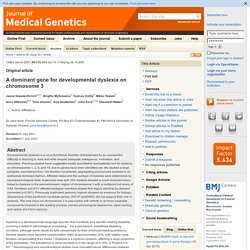
Previous studies have suggested mostly quantitative susceptibility loci for dyslexia on chromosomes 1, 2, 6, and 15, but no genes have been identified yet. We studied a large pedigree, ascertained from 140 families considered, segregating pronounced dyslexia in an autosomal dominant fashion. Dyslexia is a developmental language disorder that manifests as a specific reading disability, involving a deficit in phonological processing.1 It is a permanent, sometimes disabling condition, although some adults do fully compensate for their childhood reading problems. A genome scan for developmental dyslexia confirms linkage to chromosome 2p11 and suggests a new locus on 7q32. + Author Affiliations Correspondence to: Professor J Kere, Karolinska Institute, Department of Biosciences at Novum, 14157 Huddinge, Sweden; juha.kere@biosci.ki.se Accepted 4 February 2003 Revised 3 February 2003 Abstract Developmental dyslexia is a distinct learning disability with unexpected difficulty in learning to read despite adequate intelligence, education, and environment, and normal senses.
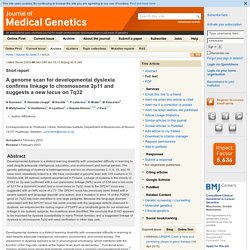
The genetic aetiology of dyslexia is heterogeneous and loci on chromosomes 2, 3, 6, 15, and 18 have been repeatedly linked to it. We have conducted a genome scan with 376 markers in 11 families with 38 dyslexic subjects ascertained in Finland. Developmental dyslexia is a distinct learning disability with unexpected difficulty in learning to read despite adequate intelligence, education, environment, and normal senses. A locus on 2p12 containing the co-regulated MRPL19 and C2ORF3 genes is associated to dyslexia. + Author Affiliations *To whom correspondence should be addressed.
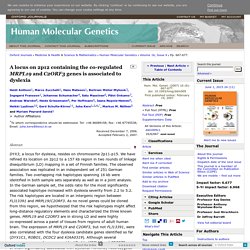
Tel: +46 86089158; Fax: +46 87745538; Email: juha.kere@biosci.ki.se Received December 7, 2006. Accepted February 2, 2007. Abstract. Amplitude envelope onsets and developmental dyslexia: A new hypothesis. Author Affiliations Communicated by James L.

McClelland, Carnegie Mellon University, Pittsburgh, PA (received for review January 25, 2002) Abstract. Auditory processing in developmental dyslexia: An exploratory study of an auditory and visual matching training program with Swedish children with developmental dyslexia. Auditory Processing of Amplitude Envelope Rise Time in Adults Diagnosed With Developmental Dyslexia. Children at Familial Risk of Dyslexia: Practical Implications from an At-Risk Study. Children with dyslexia lack multiple specializations along the visual word-form (VWF) system. Cognitive hypothesis testing and response to intervention for children with reading problems. Cognitive subtypes of dyslexia are characterized by distinct patterns of grey matter volume.
In the present study, we identified three subtypes of dyslexia with distinct cognitive and neurobiological profiles.

All had severe reading and spelling impairments compared to controls but did not differ in these measures with each other. On the neuronal level, they showed reduced GMV in the left inferior frontal gyrus relative to age-matched good readers consistent with previous studies (Brown et al. 2001; Eckert et al. 2005; Vinckenbosch et al. 2005). Importantly, this effect was common across all dyslexic subtypes.
The left inferior frontal gyrus contributed mostly to the third discriminant function, which was associated with single word and pseudoword reading, spelling, and rapid naming. In line, the activity in this area increased with reading ability and was related to rapid naming (Turkeltaub et al. 2003). The first subtype of dyslexic children had worse phonological awareness and magnocellular-dorsal skills compared to all other groups. Coloured filters improve exclusion of perceptual noise in visually symptomatic dyslexics.
Computer-assisted instruction to prevent early reading difficulties in students at risk for dyslexia: Outcomes from two instructional approaches. The relative effectiveness of two computer-assisted instructional programs designed to provide instruction and practice in foundational reading skills was examined.
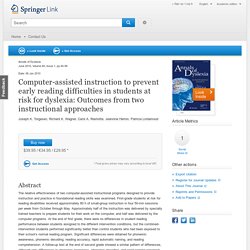
First-grade students at risk for reading disabilities received approximately 80 h of small-group instruction in four 50-min sessions per week from October through May. Approximately half of the instruction was delivered by specially trained teachers to prepare students for their work on the computer, and half was delivered by the computer programs. At the end of first grade, there were no differences in student reading performance between students assigned to the different intervention conditions, but the combined-intervention students performed significantly better than control students who had been exposed to their school’s normal reading program.
Context-Dependent Encoding in the Human Auditory Brainstem Relates to Hearing Speech in Noise: Implications for Developmental Dyslexia. Figure 1 Stimulus Characteristics and Experimental Design (Top) The spectrogram of the stimulus /da/.
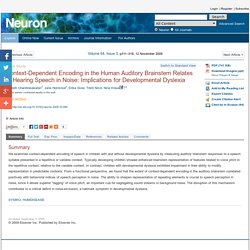
The boundary of the consonant-vowel formant transition and the steady-state vowel portion of the syllable is marked by a dashed white line. The spectrogram was generated via frequency analyses over 40 ms bins starting at time 0, and the midpoint of each bin is plotted. The stimulus /da/ is presented in variable (middle) and repetitive (bottom) contexts. Figure 2 Experiment 1: Human Auditory Brainstem Responses Are Sensitive to Stimulus Context (A) The grand averages of the time-amplitude responses in the repetitive (red) and variable (black) conditions are overlaid. Figure 3. Cortical Activation during Spoken-Word Segmentation in Nonreading-Impaired and Dyslexic Adults.
Päivi Helenius1, Riitta Salmelin1, Elisabet Service2, John F.
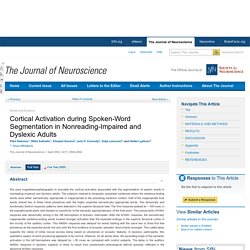
Connolly3, Seija Leinonen4, and Heikki Lyytinen4 +Show Affiliations The Journal of Neuroscience, 1 April 2002, 22(7): 2936-2944; Abstract. Current Status of Treatments for Dyslexia: Critical Review. Developmental dyslexia: the visual attention span deficit hypothesis. Deviant processing of letters and speech sounds as proximate cause of reading failure: a functional magnetic resonance imaging study of dyslexic children. Participants Eighteen children with a diagnosis of dyslexia [mean age: 9.39, standard deviation (SD): 0.43, one female] and 16 children without reading impairment (mean age: 9.43, SD: 0.44, four females) participated in the study.
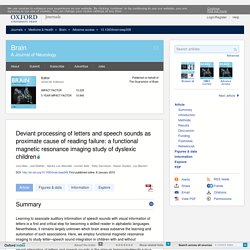
All subjects were healthy, right-handed, native Dutch speakers with normal or corrected-to-normal vision and normal audition. Dyslexic subjects were recruited via the Dutch Regional Institute for Dyslexia and diagnosed using an extensive, standardized cognitive-behavioural test procedure. Non-impaired readers were recruited via local schools.
Dyslexia and psychosocial factors. A follow-up study of young Norwegian adults with a history of dyslexia in childhood. Research Article Dyslexia and psychosocial factors. A follow-up study of young Norwegian adults with a history of dyslexia in childhood 2003, Vol. 57, No. 3 , Pages 221-226 Anne Mari Undheim. Dyslexia: Cultural Diversity and Biological Unity. The recognition of dyslexia as a neurodevelopmental disorder has been hampered by the belief that it is not a specific diagnostic entity because it has variable and culture-specific manifestations. In line with this belief, we found that Italian dyslexics, using a shallow orthography which facilitates reading, performed better on reading tasks than did English and French dyslexics.
However, all dyslexics were equally impaired relative to their controls on reading and phonological tasks. Dyslexia speed problems in a transparent orthography. Early development of children at familial risk for Dyslexia - follow-up from birth to school age. Early motor development and later language and reading skills in children at risk of familial dyslexia. Effects of Bottom-Up and Top-Down Intervention Principles in Emergent Literacy in Children at Risk of Developmental Dyslexia: A Longitudinal Study.
Mikael Heimann This longitudinal study focused on the effects of two different principles of intervention in children at risk of developing dyslexia from 5 to 8 years old. The children were selected on the basis of a background questionnaire given to parents and preschool teachers, with cognitive and functional magnetic resonance imaging results substantiating group differences in neuropsychological processes associated with phonology, orthography, and phoneme—grapheme correspondence (i.e., alphabetic principle).
The two principles of intervention were bottom-up (BU), “from sound to meaning”, and top-down (TD), “from meaning to sound.” Thus, four subgroups were established: risk/BU, risk/TD, control/BU, and control/TD. Computer-based training took place for 2 months every spring, and cognitive assessments were performed each fall of the project period. . © Hammill Institute on Disabilities 2011. Effects of Three Interventions on the Reading Skills of Children With Reading Disabilities in Grade 2. Efficacy of small group reading intervention for beginning readers with reading-delay: a randomised controlled trial. Evidence for aberrant auditory anatomy in developmental dyslexia. <p class="nojs"><strong>Warning:</strong> The NCBI web site requires JavaScript to function.
<a href="/guide/browsers/#enablejs" title="Learn how to enable JavaScript" target="_blank">more... </a></p> Sign in to NCBI US National Library of Medicine National Institutes of Health Proc Natl Acad Sci U S A. 1994 Aug 16; 91(17): 8010–8013. From genes to behavior in developmental dyslexia. Growing Up with Dyslexia: Interviews with Teenagers and Young Adults. Interviews with Teenagers and Young Adults Abstract Interviews with 75 teenagers and young adults were performed to investigate how young people with dyslexia experienced school in terms of well-being, educational achievement, self-esteem, peer relations and belief in their future. Results from earlier studies suggest that secondary emotional problems are common.
The first six grades in school were experienced by the interviewees as full of distress and failure for a majority. Though peer relations were often good, many had experienced bullying. How auditory temporal processing deficits relate to dyslexia. Braz J Med Biol Res, July 2009, Volume 42(7) 647-654 How auditory temporal processing deficits relate to dyslexia. Implicit Learning and Dyslexia. Is developmental dyslexia a disconnection syndrome?: Evidence from PET scanning. Learning Strategies and Study Approaches of Postsecondary Students With Dyslexia. NRDC : A review of research on developmental dyslexia in adults (Completed) Orton-Gillingham and Orton-Gillingham—Based Reading Instruction.
A Review of the Literature. Paying attention to reading: The neurobiology of reading and dyslexia. Research Article. Phonological and semantic contributions to children's picture naming skill: Evidence from children with developmental reading disorders. The full text article is temporarily unavailable. Phonological spelling errors in the writing of Greek dyslexic children: in support of the phonological deficit theory. Project DyAdd: Phonological Processing, Reading, Spelling, and Arithmetic in Adults With Dyslexia or ADHD. Pekka Tani. Reading Learning Disorder. Revista da Sociedade Brasileira de Fonoaudiologia - Relationship between neuroimaging findings and auditory and metaphonological abilities in students with developmental dyslexia.
Relação entre achados em neuroimagem, habilidades auditivas e metafonológicas em escolares com dislexia do desenvolvimento. Sound-Symbol Learning in Children with Dyslexia. Speech-perception-in-noise deficits in dyslexia. The education of dyslexic children from childhood to young adulthood. The language learning experiences of students with dyslexia: lessons from an interview study. The relationship between attention, executive functions and reading domain abilities in attention deficit hyperactivity disorder and reading disorder: a comparative study - Bental - 2007 - Journal of Child Psychology and Psychiatry.
Theories of developmental dyslexia: insights from a multiple case study of dyslexic adults. Psychometric tests Results are presented in Table 1. The two groups were adequately matched for sex (eight males and eight females in each group), handedness (two controls and one dyslexic left‐handed) and full‐scale IQ. Dyslexics scored significantly higher on one performance subtest of the WAIS, picture completion [F(1,30) = 6.1, P < 0.05]. On the other hand, they scored significantly lower in verbal IQ [F(1,30) = 6.5, P = 0.016], which is directly attributable to their significantly lower scores in two verbal subtests of the WAIS: digit span [F(1,30) = 21, P < 0.001] and letter–number sequencing [F(1,30) = 14.9, P = 0.001].
Furthermore, they were marginally poorer at arithmetic [F(1,30) = 3.6, P = 0.069]. In order to summarize literacy performance for the purpose of deviance analysis, we converted the six relevant variables into Z‐scores, and averaged these Z‐scores to produce a single variable called LITERACY, also shown in Table 2. There are Multiple Contributors to the Verbal Short-Term Memory Deficit in Children with Developmental Reading Disabilities. The full text article is temporarily unavailable. Tip-of-the-Tongue and Word Retrieval Deficits in Dyslexia. Variation in GRIN2B contributes to weak performance in verbal short-term memory in children with dyslexia. How to Cite Ludwig, K. Very early phonological and language skills: estimating individual risk of reading disability. "Visual problems in dyslexia" Kristen Pammer 2013. "Visual attention, reading and dyslexia" Trichur Vidyasagar 2013. What's the link between speed and reading in children with dyslexia?